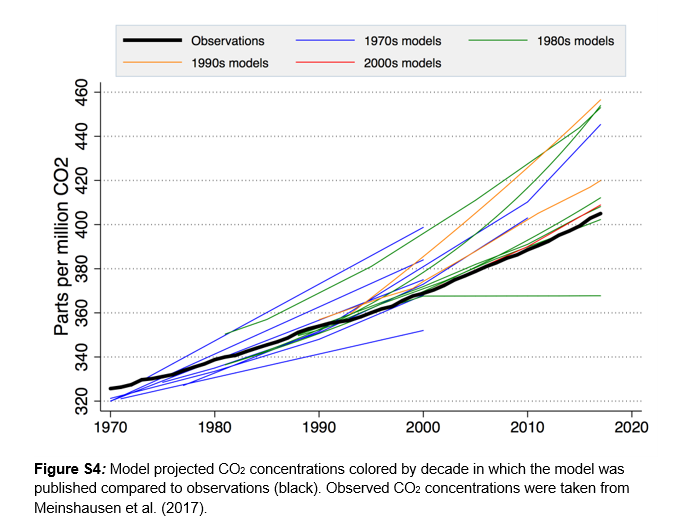I have a column today on the IPCC& #39;s RCP8.5 GHG emissions scenario. https://business.financialpost.com/opinion/ross-mckitrick-the-flaw-in-relying-on-a-worst-case-scenario-climate-model">https://business.financialpost.com/opinion/r...
RCP8.5, like A1FI and others before it, is part of a history of exaggerated top-end scenarios that create misleading pictures about the business-as-usual future.
RCP8.5, like A1FI and others before it, is part of a history of exaggerated top-end scenarios that create misleading pictures about the business-as-usual future.
h/t @RogerPielkeJr and his coauthors who have been doing a lot to push back against misuse of RCP8.5 in the academic community.
Modelers create a range of emission/concentration scenarios where the bottom end is realistic but largely benign and the top end is implausible and scary. Then they mislabel the top end the "no-policy" future and use it to call for deep emission cuts.
It should be noted that for 40 years we& #39;ve been on a "no-policy" business-as-usual path since despite all the rhetoric, nations have deviated little from historical emission trends, notwithstanding Kyoto, Paris and the rest.
When we compare past trends to the scenario ranges the top-end is clearly not a "no policy" scenario it is an implausible exaggerated worst-case pathway. In the case of RCP8.5 the coal-use projections have to be seen to be disbelieved: https://osf.io/preprints/socarxiv/ahsxw/">https://osf.io/preprints...
The apparent point of the emission cuts is to get us from the top end of the emission projection range to the bottom end. What the IPCC doesn& #39;t tell us is we are already there. We& #39;ve always been at the bottom end of such ranges even without GHG policies.
I include an adapted version of this remarkable graph from @Hausfather et al. GRL 2019 (Fig S4) comparing actual CO2 concentrations (black) to projections (colored) made from the 70s through to the 00s.
About 20 years ago I was cc& #39;d on an email exchange between Martin Manning, IPCC WG1 Vice-Chair and IPCC reviewer Vincent Gray, who demanded to know why the top-end warming forecast had jumped 1.5C between the final report draft and the published version.
Manning said it was wasn& #39;t from any change in the climate models, it was the last-minute inclusion of A1FI at the behest of government reviewers, over the objections of some climate modelers who thought it was unrealistic.
I don& #39;t still have the emails but I wrote about the episode in an op-ed published on April 4 2002 in the Financial Post
https://www.rossmckitrick.com/uploads/4/8/0/8/4808045/polscience.pdf">https://www.rossmckitrick.com/uploads/4...
https://www.rossmckitrick.com/uploads/4/8/0/8/4808045/polscience.pdf">https://www.rossmckitrick.com/uploads/4...
I published a couple of academic papers ( https://www.rossmckitrick.com/emission-trends.html)">https://www.rossmckitrick.com/emission-... earlier this decade looking at the SRES scenario group. My coauthors and I (including @JoelWWood ) found the top half of the scenario range improbable compared to the bottom half,
based on comparisons against per capita emission trends and price implications in global energy markets of the high end consumption scenarios.
I have written elsewhere about climate models overstating warming in the troposphere, and what it implies about their feedback processes.
https://www.rossmckitrick.com/model-testing--hiatus.html">https://www.rossmckitrick.com/model-tes...
The IPCC has cited this work (and cites it in the AR6 drafts). They don& #39;t cite my work on emission scenarios.
https://www.rossmckitrick.com/model-testing--hiatus.html">https://www.rossmckitrick.com/model-tes...
The IPCC has cited this work (and cites it in the AR6 drafts). They don& #39;t cite my work on emission scenarios.
In his accompanying column
https://business.financialpost.com/opinion/terence-corcoran-if-we-unquestioningly-follow-the-science-it-could-lead-us-nowhere,">https://business.financialpost.com/opinion/t... @terencecorcoran quotes Stephen Schneider& #39;s famous "we have to offer up scary scenarios" speech, where he advised his colleagues to choose between "being effective and being honest."
https://business.financialpost.com/opinion/terence-corcoran-if-we-unquestioningly-follow-the-science-it-could-lead-us-nowhere,">https://business.financialpost.com/opinion/t... @terencecorcoran quotes Stephen Schneider& #39;s famous "we have to offer up scary scenarios" speech, where he advised his colleagues to choose between "being effective and being honest."
Treating it as an either/or choice has in my view led to neither being achieved.

 Read on Twitter
Read on Twitter


